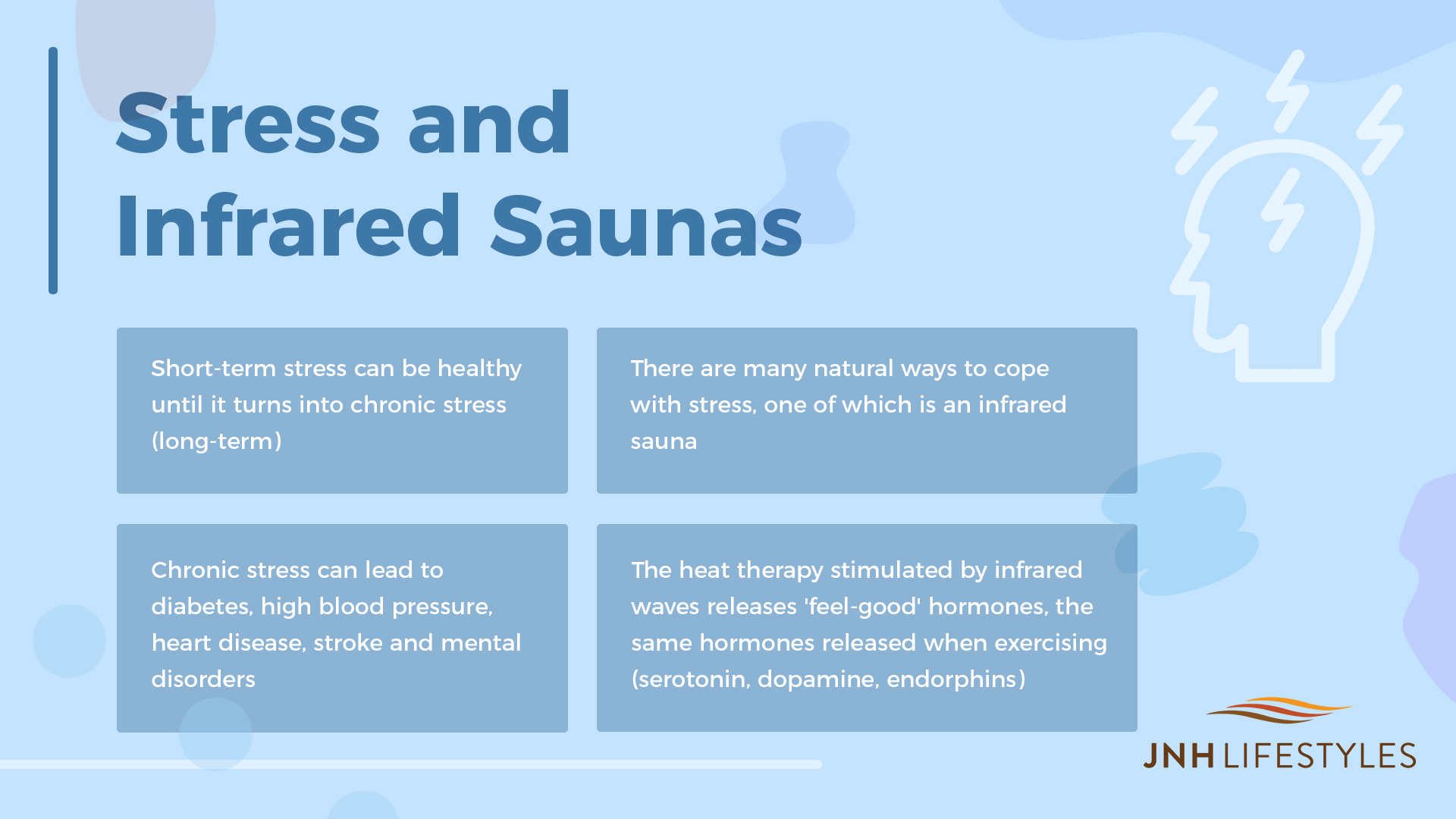Life Got You Stressed? Infrared Saunas Can Help, Here's How!
Stress happens to everyone. It doesn’t care about gender, race or economic status. Children, adults and the elderly all experience some sort of stress, which takes a toll on their health and lives. This is a condition that affects you regardless of who you are, what you do and where you are from. Because of this, there are two types of stress you may experience: positive and negative.
Positive stress is when you get jitters about something nice happening in your life, like a wedding or birthday. Negative stress is connected to unpleasant occasions, ranging from traumatic events to bad weather. Both types of stress can affect your physical and mental health since they incite strong reactions and promote excessive production of adrenaline and cortisol – the stress hormones. These naturally occurring chemicals in the body are responsible for keeping you on high alert when you face something troubling, otherwise called the “fight or flight mechanism.”Too much cortisol can have serious health consequences, like Cushing’s syndrome, anxiety, and depression.
Since stress can’t be eliminated, you need to learn how to control it so it doesn’t affect your quality of life[1]. While what is effective varies from person to person, the idea is the same – to remove the stressors and calm the body and mind. Infrared saunas can have many advantages which make them appropriate for taking care of a wide range of stressors and helping you find your Zen. Fighting stress is not a one-time thing but rather a continuous battle, and finding the perfect strategy is vital to limiting its impact on your well being [2].
How To Cope With Stress

While even the smallest amount of stress can turn your world upside down, the real danger lies in long-term exposure. This is called chronic stress, which keeps your body in a constant state of fight and flight, and away from normal functioning. Because of this, certain systems in your body get disturbed, like immunity, digestion, and sleep. If the pressure on your body continues, it can lead to serious health problems, such as diabetes, high blood pressure, heart disease, stroke, and mental disorders.
Stress management includes several techniques. Sometimes one will work, but you'll mostly have to combine a couple or more to create an effective strategy that can help you navigate stress. The first step in coping is to recognize the signs that you are under stress to begin with. This includes identifying changes in your behavior that are negatively affecting your everyday life, e.g. difficulty sleeping, substance abuse, anger, fatigue, and depression.
Steps That Can Help
There are several ways to deal with stress and it all depends on what makes you comfortable. Some people find maintaining overall wellness calming so they can concentrate on a more positive outlook on life. Examples of this include releasing negative energy through massage, acupuncture and meditation. Nature also has beneficial effects on stress since it offers freedom, tranquility, colors and an escape from what some would call urban chaos. If you have an opportunity, go on regular hikes, camping or bicycle rides in a nature park to de-stress. This is also a great way to get physical activity, which can also be a great resource for fighting off stress. When you exercise, the body releases feel-good hormones, like serotonin, dopamine, and endorphins that improve your mood and give you energy.
Talking to someone can also give you more insights on your stressors and how to handle them. Experts, like psychiatrists, have professional experience and can even suggest medication, strategies and help you identify the root cause of your stress. Additionally, sharing your worries with someone you trust, like a family member, friend or partner can provide you with emotional support. This can help you set your goals and priorities, as well as find the strength to realize what your issues are and lower your stress to tolerable levels.
Infrared Saunas As Stress Relief

When it comes to infrared sauna benefits, they can offer means to relieve stress or lessen its consequences. For example, if you suffer from constant pain due to injury or a health condition, the regular use of infrared sauna therapy can reduce said pain and help you function as normal as possible. Since anxiety and depression can be very common in people who are under a lot of stress, infrared has shown some promising positive results in treating these conditions [3].
If your source of stress stems from your physical appearance, an infrared sauna can help you with that. It can be part of your weight loss regime, because when regular exercise is paired with infrared sauna therapy, it can help you burn more calories [4]. Moreover, infrared waves can rejuvenate the skin and promote the production of collagen, making you look more radiant, firmer and younger [5]. For some, this is the confidence boost they need to come face to face with their stress.
So you see, sometimes the perfect way to stand up to your stress can be to give yourself the strength to resist it or fight it. With infrared sauna therapy right in your home, you can have easy access to a powerful tool that can protect your health from damage caused by stress or help you manage it more efficiently.

Resources:
[1] Colović, O, et al. (2009). “The impact of stress-related disorders on quality of life.” ncbi.nlm.nih.gov, National Center for Biotechnology Information, June 2009, https://www.ncbi.nlm.nih.gov/pubmed/19556949.
[2]TsaiSR, and Hamblin M.R. (2017). “Biological effects and medical applications of infrared radiation.” ncbi.nlm.nih.gov, National Center for Biotechnology Information, May 2017, https://www.ncbi.nlm.nih.gov/pmc/articles/PMC5505738/.
[3] Schiffer, F, et al. (2009). “Psychological benefits 2 and 4 weeks after a single treatment with near-infrared light to the forehead: a pilot study of 10 patients with major depression and anxiety.” behavioralandbrainfunctions.biomedcentral.com, BMC, December 2009, https://behavioralandbrainfunctions.biomedcentral.com/articles/10.1186/1744-9081-5-46.
[4] Kim, Sungwoon, et al. (2017). “Does treadmill walking with near-infrared light applied to the abdominal area reduce local adiposity and body weight?” ncbi.nlm.nih.gov, National Center for Biotechnology Information, October 2017, https://www.ncbi.nlm.nih.gov/pmc/articles/PMC5684004/.
[5] Wunsch, A and Matuschka, K. (2014). “A Controlled Trial to Determine the Efficacy of Red and Near-Infrared Light Treatment in Patient Satisfaction, Reduction of Fine Lines, Wrinkles, Skin Roughness, and Intradermal Collagen Density Increase.” ncbi.nlm.nih.gov, National Center for Biotechnology Information,February 2014, https://www.ncbi.nlm.nih.gov/pmc/articles/PMC3926176/.

